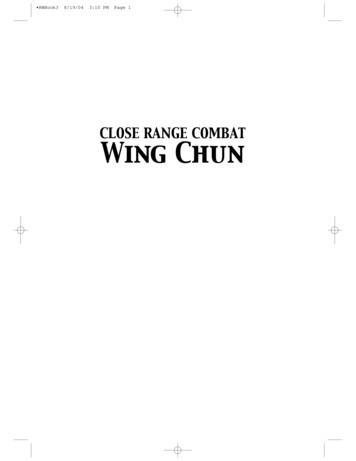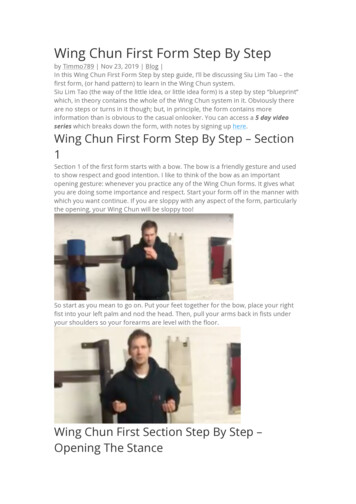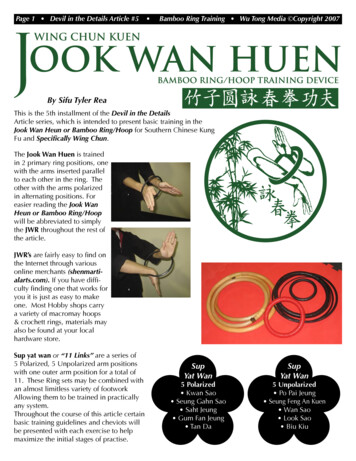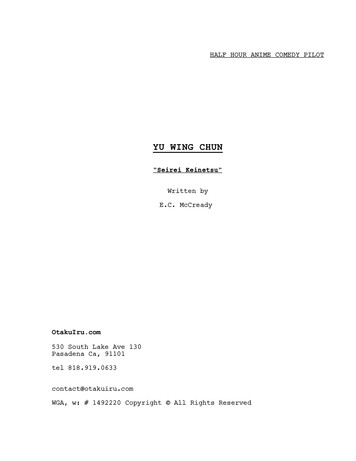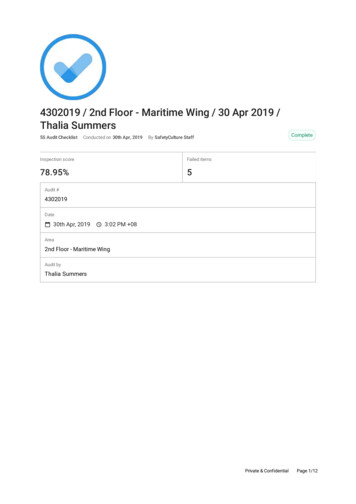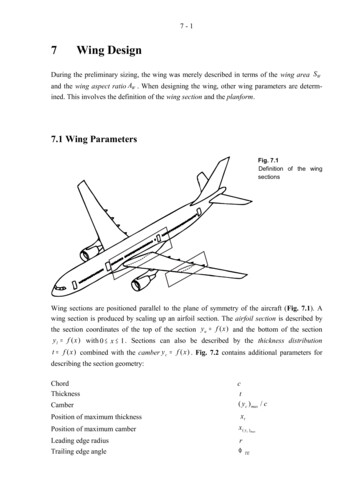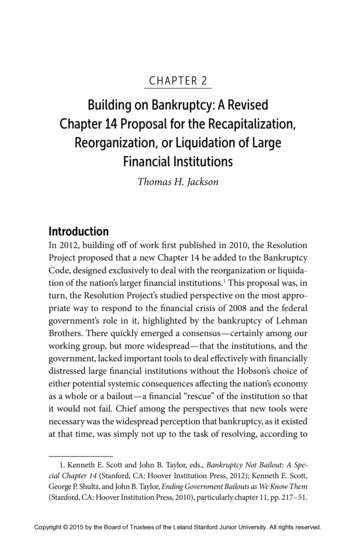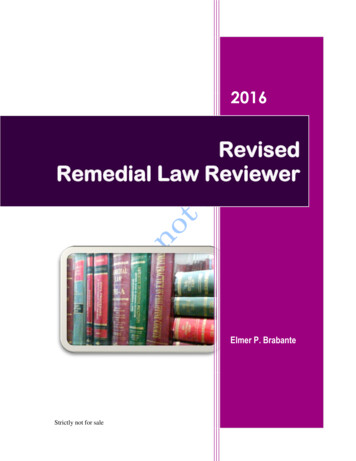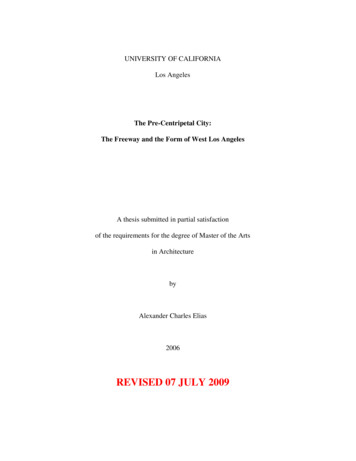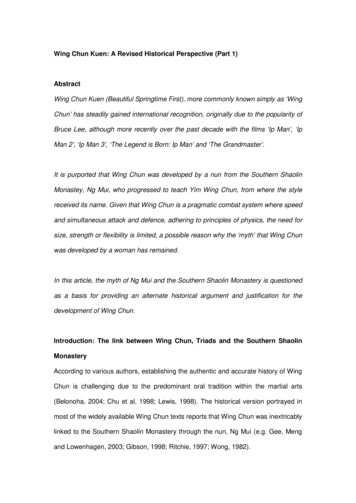
Transcription
Wing Chun Kuen: A Revised Historical Perspective (Part 1)AbstractWing Chun Kuen (Beautiful Springtime First), more commonly known simply as ‘WingChun’ has steadily gained international recognition, originally due to the popularity ofBruce Lee, although more recently over the past decade with the films ‘Ip Man’, ‘IpMan 2’, ‘Ip Man 3’, ‘The Legend is Born: Ip Man’ and ‘The Grandmaster’.It is purported that Wing Chun was developed by a nun from the Southern ShaolinMonastey, Ng Mui, who progressed to teach Yim Wing Chun, from where the stylereceived its name. Given that Wing Chun is a pragmatic combat system where speedand simultaneous attack and defence, adhering to principles of physics, the need forsize, strength or flexibility is limited, a possible reason why the ‘myth’ that Wing Chunwas developed by a woman has remained.In this article, the myth of Ng Mui and the Southern Shaolin Monastery is questionedas a basis for providing an alternate historical argument and justification for thedevelopment of Wing Chun.Introduction: The link between Wing Chun, Triads and the Southern ShaolinMonasteryAccording to various authors, establishing the authentic and accurate history of WingChun is challenging due to the predominant oral tradition within the martial arts(Belonoha, 2004; Chu et al, 1998; Lewis, 1998). The historical version portrayed inmost of the widely available Wing Chun texts reports that Wing Chun was inextricablylinked to the Southern Shaolin Monastery through the nun, Ng Mui (e.g. Gee, Mengand Lowenhagen, 2003; Gibson, 1998; Ritchie, 1997; Wong, 1982).
An overview of Wing Chun’s development is that Ng Mui was one of five survivors tohave escaped the destruction of the Southern Shaolin Monastery by the Qingimperial troops. Each survivor is purported to have developed their own unique styleof martial art. Mg Mui taught her skills to a young woman, Yim Wing Chun from whichthe name of the style derives. Yim Wing Chun in turn taught her husband, Leung BokChau, before the style was transmitted to others through a variety of lineages(Belonoha, 2004; Chu et al, 1998; Gee et al, 2003; Gibson, 1998; Ip and Tse, 1998;Kernspecht, 1987; Yip and Connor, 1993).However, this account has been questioned by Chu et al (1998) who proposed thatthe origin of Wing Chun was closely aligned to the development of political sects,such as the Tiandihui, or ‘Society of the Heaven and Earth’, more commonly knownas the ‘Triads’. Unfortunately, Chu et al (1998) did not provide academic support tosubstantiate their claim, consequently this article will analyse available academicsources in an attempt to corroborate or refute their assertion through the adoption ofan hermeneutic approach which attempts to analyse and interpret the meaningsgenerated within an historical text through a modern perspective (Braud andAnderson, 1998; Cohen, Manion and Morrison, 2007; Haslam and McGarty, 2003;Kincheloe and Berry, 2004; Robson, 2002).Given the assertion by Chu et al (1998) that there is a relationship between WingChun and the Tiandihui, there is one source that unites their heritage which can beexplored further: that both Wing Chun and the Tiandihui have both claimed to haveoriginated from the Southern Shaolin Monastery. The destruction of the Monastery bythe Qing Empire being the catalyst for the development of both Wing Chun and theTiandihui.
While Wing Chun’s history is poorly documented, and as previously discussed, hasbeen transmitted orally which may lead to embellishment, the historical accounts ofthe Tiandihui are far stronger (Bolz, 1995; Booth, 1999; Murray, 1994; Overholt,1995; Ownby, 1993; ter Haar, 1997). Due to the strength of the historical accounts ofthe Tiandihui, a logical argument may be proposed adhering to the modus tollens (or‘the mode of taking’) structure, whereby if the evidence for one element is strongerthan the other element, but that both share similarities, then the argument can beaccepted for the weaker element. Although this is confusing to follow, Weston (2000)summarises the structure as: ‘If p then q, and not q, therefore not p’. To illustrate this,the argument is summarised below: If Wing Chun originated from the Southern Shaolin Monastery, then so wouldthe Tiandihui (if p then q). The Tiandihui did not originate from the Southern Shaolin Monastery (not q). Therefore, Wing Chun did not originate from the Southern Shaolin Monastery(therefore not p).Conversely, there is a further argument structure, modus ponens (or ‘the mode ofputting’), which can be applied (Weston, 2000). This is summarised as: ‘If p then q, p,therefore q’, or more simply, p implies q. If p is true, therefore q must also be true.Consequently, if historical accounts of the Tiandihui can verify the existence of theSouthern Shaolin Monastery, then the claim for Wing Chun deriving from theSouthern Shaolin Monastery is significantly strengthened.From this, the two arguments centre on ascertaining whether any credible evidenceexists for the Southern Shaolin Monastery, and given that historical accounts for the
Tiandihui are stronger than Wing Chun, it is necessary to analyse the accounts fromthe Tiandihui.The link between the Tiandihui and the Southern Shaolin MonasteryThe Tiandihui operated as a fraternity in a time of political turmoil. As such, it couldbe viewed as a ‘cooperative’ or mutual support organisation. Central to Tiandihui loreis the importance placed upon historical background and lineage. When a candidateprogresses through the initiation ceremony, they are told of the history of theTiandihui, which is known as the ‘foundation account’ or the ‘Xi Lu Legend’ (Booth,1999; Murray, 1994; Overholt, 1995; Ownby, 1993; ter Haar, 1997).This narrative of the Xi Lu Legend provided a justification for the Tiandihui’sexistence and their associated cause. Unfortunately, establishing accurate historicalconfirmation of the evidence for the Xi Lu Legend has been problematic.While Tai Hsuan-Chih (1977) suggested that the Tiandihui mythology has remainedunchallenged by scholars due to the subject being considered unworthy for seriousacademic investigation, an additional problem is that there are at least sevendifferent versions of the foundation account (Booth, 1999; Murray, 1994; Ownby,1993).A leading academic of Chinese history, Professor Dian Murray, has provided anoverview of the Xi Lu Legend:In all versions, the plot is much the same. The monks of the Shaolin templego to the aid of the emperor in quelling an invasion by the Xi Lu ‘barbarians,’ . After returning to the capital in triumph, the monks refuse all forms of
monetary reward or investiture as officials . But the emperor’s gratitudeturns to wrath when the monks are accused of plotting rebellion, and theirmonastery is reduced to ashes eighteen manage to take flight. Thirteen ofthem succumb to the hardships of the road, leading a band of only five todevote themselves to revenge against the Qing and the subsequent foundingof the Tiandihui In every version of the legend, the monks’ endeavours areencouraged by the sudden appearance of a white incense burner, whichfloats either to the surface or to the edge of a body of water and is inscribedwith the words ‘Fan-Qing fu-Ming’. (Murray, 1994: 153-4).The seven versions of the foundation account have been summarised in Table 1,although as Murray (1994) has discussed, each account has become progressivelymore elaborate over the years: although the plot generally remains consistent,inconsistencies arise between characters, place names, dates, actions, etc.
Table 1: A summary of the seven Chinese versions of the Xi Lu legend (adapted from Murray, 1994:197-227).VersionDoc 1Yao DagaoDoc 2Yang FamilyDoc 3Gui CountyYear cited27th June, 18111820s or 1830sEarly 1830sXi LuInvasionKanxi periodNo mentionNo mention16th year of Kangxireign (1677)Location ofShaolinMonasteryNumber ofmonksBetrayed byGansuNo mentionNo mention128No mention108Jiulian Mountain,Fuzhou prefecture,Fujian province128TreacherousofficialNo mentionNo mentionMa ErfuZhang LianqDeng ShengNo mentionNo mentionJealousy of beingfavoured byemperorHow manyescapedHow manysurvivedNames ofmonks18No mentionBroke a valuablelamp andsubsequentlyexpelled18186 teachers and 1pupilNo mention55No mentionNo mentionEscape aidedbyNo mentionNo mentionNo mentionDate of oath25th day of 7thmonth of jiayinyearNo mention25th day of 7thmonth of jiayinyearGaoxi Temple,25th day of 3rdmonth of jiayinyear (1674)Gaoxi TempleReason forbetrayalPlace of oathDoc 4‘Xi Lu Xu’ orShouxion1851 – 1861Doc 5‘Xi Lu Xu Shi’ orNarration1851-61 or 186274Jiawu year ofKangxi reign(1714)No mention128Doc 6‘Xi Lu Xu’ ofPreface1851 – 1874Jiawu year ofKangxi regin(1714)Jiulian Mountain,Pulong county,Fujian128Doc 7HirayamaLate 19th/early 20thcenturyKangxi periodJiulian MountainNo mentionJianqiu Zhang &Chen HongNo mentionMa1818185555Wu Zuotian, FangHuicheng, ZhangJingzhao, YangWenzuo, LinDagangZhu Guang & ZhuKai (turned into abridge)No mentionLiu , Guan, ZhangCai, Fang, Ma, Hu,LiCai Dezhong,Fang Dehong, MaChao-xing, HuDedi, Li ShikaiZhu Guang & ZhuKai (turned into abridge)25th day of 7thmonth of jiayinyearGaoxi temple ofZhu Guang & ZhuKai (turned into abridge)25th day of 7thmonth of jiayinyearNo mentionNo mentionSeduced a monk’s(Zheng Junda)wife and sister25th day of 7thmonth of jiayinyearRed Flower
GaozhouprefectureName ofbrotherhoodHong familyHonglian shenghui(Vast Lotus VictorySociety)Date WanYunlongkilledWan YunlongBuried at9th day of 9thmonthUnknownShicheng onNo mentionHong familyNo mentionNo mentionNo mention – butthe three dotrevolution ‘toexterminate theQing, restore theMing and to sharehappiness,prosperity, andpeace with allunder Heaven’(Murray, 1994,p.203)No mentionNo mention9th day of 9thmonth9th day of 9thmonth9th day of 9thmonthNo mentionNo mentionNo mentionFive Phoenix(Wufeng)MountainTwelve Summit(Shi’ erfeng)MountainDing Mountain
In returning to the fundamental reason for highlighting the Tiandihui history, if there isone decisive piece of evidence within the Xi Lu Legend that verifies the existenceSouthern Shaolin Monastery, then this strengthens the argument for Wing Chunsimilarly originating from the Monastery.Although the Southern Shaolin Monastery is central to the Xi Lu legend, arguablythere are two inextricable linked aspects to consider in verifying the authenticity ofthe Monastery:i)whether the Monastery existed, andii) its geographical location.In relation to the location for the Monastery, Murray (1994) heighted how the differentversions of the Xi Lu Legend (summarised in Table 1), differ. If the versions of thevarious accounts could be triangulated to verify the same location, the ngtheMonastery’sexistence.Unfortunately debate has continue as to the exact location of the Monastery, withthree locations that appear most feasible being Putian, Quanzhou and Gaoxi.PutianIn support of the Putian claim, the Putian Government comment that,It is a great discovery that the remnants of the Southern Shaolin Temple hasbeen found and been confirmed. On April 25, 1992, with the approval of thePeople’s Government of Fujian, the Putian City Government held a pressconference in the People’s Great Hall to announce that they would rebuildSouthern Shaolin Temple. (Putian Government, 2006: online)
Regrettably the Putian Government did not provide any evidence which confirmedthe existence of the discovered Temple. Although Gee et al (2004) have supportedthe Putian claim, they have similarly failed to discuss what contributed to thearchaeological evidence, except their personal testimony (Gee et al, 2003).QuanzhouAlthough the Putian claim lacks any evidence to date, the alternate Quanzhou claimappeared stronger, with the evidence relating to written historical reports. ter Haar(1997) discussed the discovery of the ‘Mixed Records from the Western Mountain’(xishan zazhi) written by Cai Yongjian (1776-1835), whereby a Southern ShaolinMonastery may have been located next to the Eastern Machmount Temple.However, ter Haar (1997) questioned the authenticity of the document, suggestingthat it may have been a duplication from the late-Qing novel ‘Wannianqing qicaixinzhuan’. As such, one text may have been copied from the other, alternately bothtexts may have evolved from a third historical source. Consequently, ter Haarsuggested that further research would be required due to the Tiandihui’s foundationaccount of the Southern Shaolin Monastery varying considerably to the ‘MixedRecords from the Western Mountain’. ter Haar (1997) concluded that towards theend of the eighteenth century, stories about the destruction of a real or widely.Thesestoriesweresubsequently adopted by Tiandihui and martial artists for their own purposes.GaoxiOne location that is strongly associated with the site where the Tiandihui wasestablished is the Guanyinting (or ’Goddess of Mercy Pavillion’) in the Gaoxitownship, Zhangpu county, Zhangzhou prefecture, Fujian (Murray, 1994). Murrayasserted that the Tiandihui were established in 1761 or 1762 and has providedcredible sources to support her research. Although this location may have been the
inaugural location for the Tiandihui, the Pavillion is little more than a remote, roadsidehut and is therefore unlikely to have been the location for the actual Southern ShaolinMonastery (see Picture 1, Picture 2)Picture 1: Prof. Dian Murray outside the Guanyinting in the 1980s (Photo used withpermission from D. Murray).
Picture 2: Prof. Dian Murray inside the Guanyinting in the 1980s (Photo used withpermission from D. Murray).From Picture 1, the Guanyinting, or ‘Goddess of Mercy Pavillion’ is little more than asmall place for roadside worshippers: it does not have the magnificence of thehistorically verified Northern Shaolin Monastery to which the reader may be morefamiliar.Al
Wing Chun Kuen (Beautiful Springtime First), more commonly known simply as ‘Wing Chun’ has steadily gained international recognition, originally due to the popularity of Bruce Lee, although more recently over the past decade with the films ‘Ip Man’, ‘Ip Man 2’, ‘Ip Man 3’, ‘The Legend is Born: Ip Man’ and‘The Grandmaster’. It is purported that Wing Chun was developed by .
